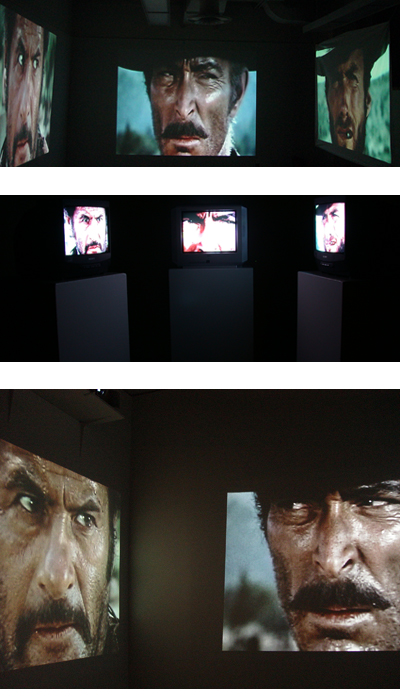Representations of sexual preference or orientation are complex processes in the cinema. From the classic scene in the Maltese Falcon in which Humphrey Bogart, having knocked Joel Cairo out, removes and sniffs Peter Lorre’s pocket square – scented, one might recall, with gardenias – to the more complex inferences of queer identity in films such as Alfred Hitchcock’s Strangers on a Train, what emerges is a visual language that is both expressed and sublimated at precisely the same time.
I begin here because when one encounters the film works and installations of Christopher Lowther, one enters, perhaps unexpectedly, into this non-verbal language of sexual desire. His works explore the subtleties, both reflected and constructed, between seemingly straightforward imagery, if I can use the term, to the constructions of motivation in works such as A Queer Shadow, Rope Reconstructed, and Rebel Love.
Begin, however, with Cowboy Cruising. Here, we encounter the climactic scene from Sergio Leone’s classic spaghetti western The Good, the Bad and the Ugly. The scene, which will be familiar to many readers, consists of a gunfight that takes place on a flat stone piazza in a cemetery.
The protagonists glance towards each other, tracking a pattern from eyes to hands to guns, looking for the telltale moment at which one will draw on the others. In Cowboy Cruising, Lowther has dissociated the glances from their original contexts, reconfigured them, and created a language of visual selection, or, a cruise.
Perhaps the most unspoken element of his deconstruction is the unspoken homoerotic element that had been sublimated throughout the film. One encounters it subtly, from the nickname given to Lee Van Cleef, “Angel Eyes”, to the sharing of a cigar between Eastwood’s Man with No Name and a wounded union soldier. But when the action is limited merely to the movements that take place in the cemetery, one experiences a clearly delineated language of the casual encounter.
Lowther explains that his motivation for this reconfiguration came while reading Chris Packard’s Queer Cowboys, a book exploring erotic male friendships from the nineteenth century. What Queer Cowboys does is explore the terrain of the male friendship, particularly that of the cowboy and his sidekick, and the apparent, though usually unspoken bond that unites the two. I should state here that Lowther began his creative investigations prior to Brokeback Mountain’s appearance, which in many senses merely served to reposition the historical into the present. At a deeper level, Lowther explains, “I think those cinematic instances in which there is a possibility of re-contextualizing something intended as heterosexual or for heterosexual audiences are special because they offer access to something that usually excludes us[.]”
One might think of the bond that unites The Man with No Name with Tuco, the sidekick played by Eli Wallach. Time and again we encounter the two, with Tuco hanging at the end of a rope, and Eastwood responsible for his freedom.
Finally, one might consider the absent phallus, the object of their desire, which is, in a sense, made evident by the missing digit on Lee Van Cleef’s hand, which transforms into that something other than a hand which is moving slowly across his belt. Taken both in and out of context, what we encounter are a group of men, glancing furtively at each other, watching slowly as each moves a hand across his belt. Given this description, in the absence of the accompanying story, one could only reach the conclusion that they were cruising each other.
This serves to reposition both the story and the subjects. What Lowther does, in this moment, is shift the discourse to that of the sexualization of the space. One might recall that, after having been left to hang in the cemetery yet again, Wallach (who is slowly being asphyxiated, and, one must assume erotically) calls out to Eastwood that his mother is a…but the music swells and the word is obliterated, obliterating the idea of woman at the same time.
excerpt taken from, "The Pick Up Artist" by Brett Levine
